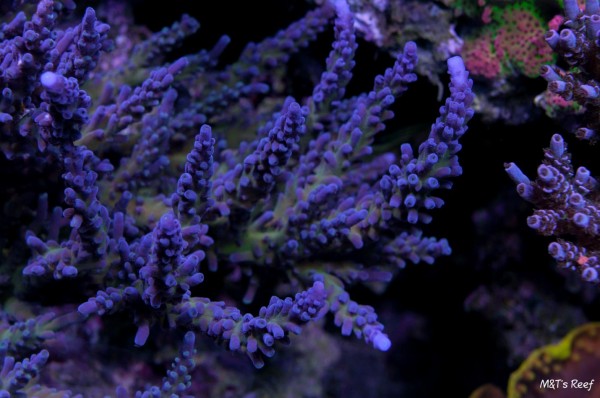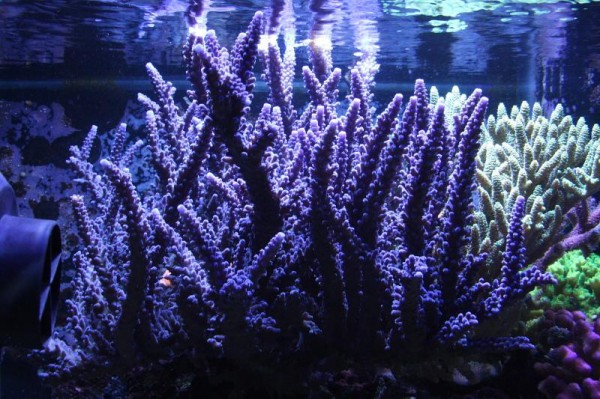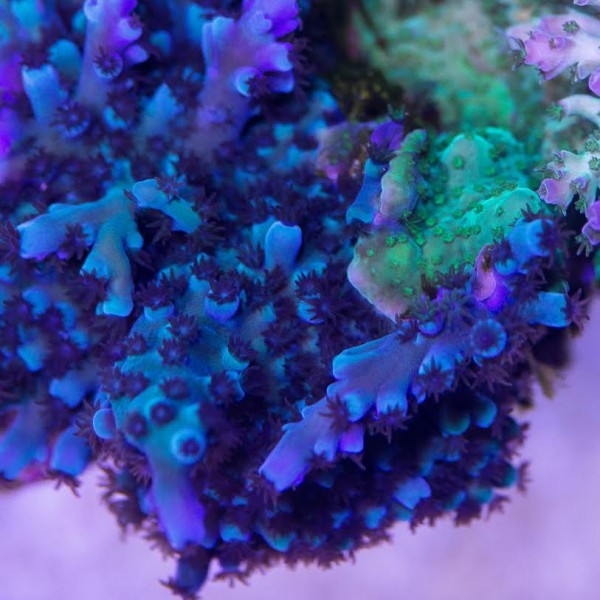SPS Spotlight: Mistaken Identity – Acropora Tortuosa And Its Imposters
SPS Spotlight: Mistaken Identity – Acropora tortuosa and Its Imposters

Figure 1. A close up look at the author’s “California Tort” (A. tortuosa) showing classic green and blue coloration.
Tortuosa are an especially interesting species of Acropora. As SPS lovers have come to know, the variety of color and growth forms in this group of corals perpetually attracts the interest of reef-aquarium hobbyists. Many environmental parameters affect a coral’s coloration; most notably light intensity and spectrum. Acropora tortuosa certainly stands out in its wide range of coloration. There are green, blue, yellow, even pale blue/white and several variants in between. As mentioned in my article the January Reef Edition, there are also different species of Acropora that are frequently mistaken for A. tortuosa. A. austera is a prime example. In fact, there are some very popular corals commonly called “Torts” that may not be Acropora tortuosa at all.
The real A. tortuosa has a narrow habitat in the wild. Its range is primarily limited to the South Pacific Ocean around Australia. Natively, A. tortuosa is a lagoon-dwelling coral with prostrate, tapered branches that have many branchlets and incipient axial corallites. Its corallites are immersed to long and tubular, giving branches a rough, irregular appearance.1 Captive and aquacultured colonies of true A. tortuosa will display very similar growth form. While all A. tortuosa specimens share that common rough, irregular, stag-like appearance, there are some subtle differences in growth rates and structure among the “varieties” offered for sale in the hobby. As mentioned, many of these so-called “torts” are subject to frequent debate about their lineage or classification.

Fig 2. Author’s “California Tort” colony, grown from 1-in. fragment.
Note the short, fairly uniform radial corallite structure
Famous Editions

Fig 3. ”Oregon Tort”. Note the tubular, irregular, curving radial corallites.
(photo courtesy of R2R member zibba)
One of the more prominent aquaculture wholesalers, ORA, currently farms two distinct brands of “Tort”: the “ORA Oregon Tort” and the “ORA Ice Tort” (for several years they also farmed the popular “California Tort”, but stopped selling that coral in early 2011.) If you are in the market for a specimen of true A. tortuosa, you’ll want to look for the “California Tort.” In this author’s opinion, this is the one coral that most consistently matches the scientific descriptions given for Acropora tortuosa.
There are other “Torts” available in the market, such as the “Miyagi Tort” or “Sean Bennett Yellow Tort,” but I question if these are truly the same species. Many display characteristics that are notably different from A. tortuousa, e.g., fused branches. For those with an eye for these types of details, you may notice that many of these “tortuosa imposters” resemble A. austera.
Arguably the most popular of the “Torts” is the “Oregon Tort,” which is considerably different from the “California Tort.” The former being noted for its uniform deep-blue coloration, slow growth rate, and tubular, irregular radial corallites. The California Tort variety is known for its blue/green coloration and faster growth. Recently, there was an exotic variety of Tort seen in the Marshall Islands, with a beautiful pale blue coloration.2 Not surprisingly, these colonies were found in shallow, clear waters rather than the normal lagoon habitat with much more turbid water in which A. tortuosa is normally found. Again, more support for the effects that environmental parameters can have on a coral’s structure and appearance.
Quick Stats:
- Care level: medium/difficult
- Lighting: moderate/high
- Placement: middle/top
- Flow: moderate/high
- Temperature: 72-80 F
- Alkalinity: 7-11 dKH
- pH: 7.8 – 8.3
- Salinity: 1.023 – 1.026
Summary
A. tortuosa is a highly sought-after SPS species because it is an attractive coral, with gorgeous coloration and an interesting growth pattern. Like many of the desirable SPS species, it is not an easy coral to keep, but it can be one that can keep your interest for many years to come.
For more sps coral discussion please visit our forum here.
1 Australian Institute of Marine Science
Author
Mike Lauderdale is . . ..

Leave a Reply
You must be logged in to post a comment.